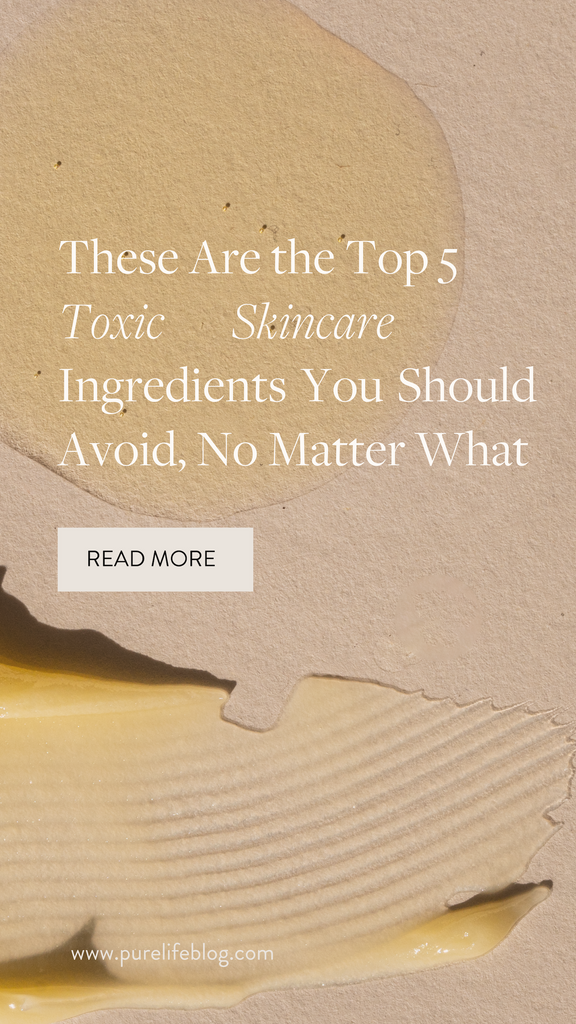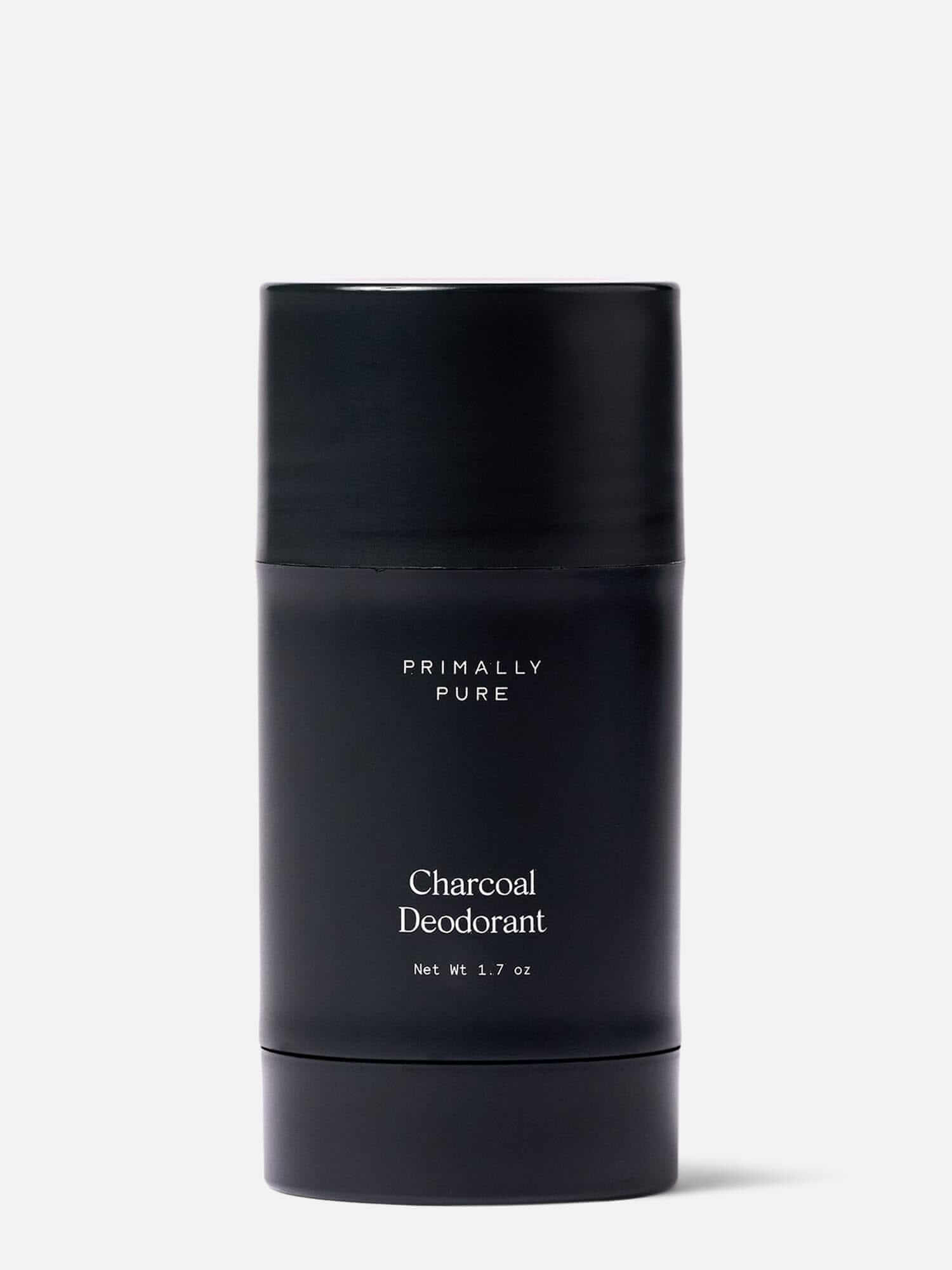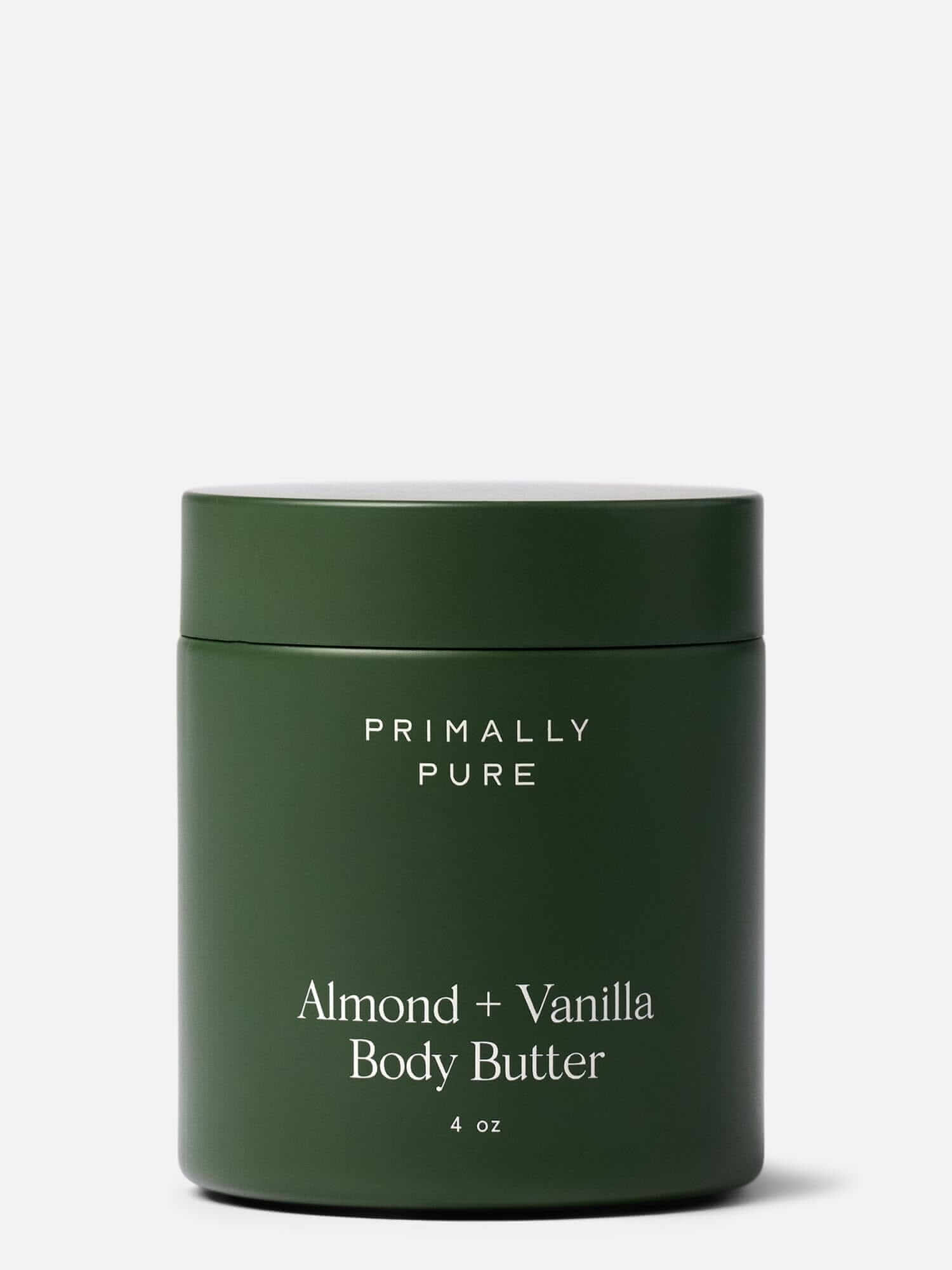These Are the Top 5 Toxic Skincare Ingredients You Should Avoid, No Matter What
Summary
Combing through product labels and cleaning up your skincare can feel overwhelming. But these top 5 toxic skincare ingredients are a great place to start.
Detox is a word that’s used on the regular these days. It’s tossed around without much consideration. We know the reality of toxic buildup in our bodies: it’s not good for us and needs to get out.
But detox is more than just a singular event. Unfortunately, we all experience mass exposure from modern technology, and regulations against harmful chemicals are lacking. So, we all need to detox as often as possible.
Toxins build up because our bodies don’t know how to absorb + assimilate these foreign ingredients. This means they continue to circulate, putting strain on our bodies rather than becoming food + nourishment for our cells.
But before you get stressed out, let’s clarify something: supporting your body’s detoxification systems doesn’t have to be complicated! The biggest, most impactful choice you can make is to refuse products with toxic skincare ingredients – and instead, embrace non-toxic skincare.
That’s why today I’m focusing on five of the most important toxic skincare ingredients to avoid. Let’s simplify this, shall we? At Primally Pure we believe in starting small and working your way into a non-toxic lifestyle.
In my opinion, eliminating toxic skincare ingredients is the best way to start. ;) But of course, it begs the question – why are there so many toxic skincare ingredients?
Why Do Toxic Skincare Ingredients End Up In My Products?
Believe it or not, conventional beauty + body products are one of the biggest contributors to your toxic load. But before we get into some technical terms (+ the top toxic skincare ingredients to avoid) let’s look at the WHY behind it all.
There are countless pollutants in our environment that we can’t control, so it’s essential to be conscious of our choices. The good news is you can actively avoid contributing to the toxic buildup in your body.
How? By what you put on your plate and apply to your skin!
To be clear, your body is self-healing at its roots. So, it’s equipped to handle occasional chemicals and exposures. But when exposed consistently and daily, the toxins stack up and you’re far more prone to unwanted diseases and health conditions.
And despite the data that shows the average woman uses about 12 products each day, with up to 114 different potentially toxic ingredients, the FDA continues to leave personal care products largely unregulated.1 (About 10 percent of adults use more than 25 products daily…)
In fact, the government turns a blind eye, allowing the personal care products industry to make its own rules and regulations! (How crazy is that?!)2And though the government isn’t protecting you, thankfully, there are steps you can take to protect yourself + your loved ones.
How to Identify Toxic Skincare Ingredients
Because the beauty industry is largely unregulated, it’s up to you to do your own research to find the safest products. There are no legal parameters for personal care products labeled as “pure,” “natural,” or “organic,” so it’s essential to understand how to look beyond the marketing claims and start to read labels carefully.
I know it’s a lot to take in – that’s why I’m going to equip you with the most potent information + tips. I’m going to show you what to look for on your product labels to begin detoxing your beauty cabinet – and stay far away from products with toxic skincare ingredients.
Truthfully, I could create a very long list of hazardous, carcinogenic, and endocrine-disrupting ingredients to avoid. But Rome wasn’t built in a day. ;)
So here are my top five specific toxic skincare ingredients (ahemmm… chemicals!) you absolutely want to avoid in your skincare products.
1. FRAGRANCE/“PARFUM”
I toootally get it. We all want to smell fresh + floral! And there’s a reason the smell of the outdoors calms and grounds us. Aromas are a big part of our lives!
But this is potentially the single biggest toxic skincare ingredient to avoid. Some even call it the new second-hand smoke.
→ Why?
Chemically engineered scents (called fragrance or “parfum” on the labels) can contain any combination of up to 3,500+ toxic ingredients, including hormone disruptors and allergens.
Companies can get away with this (without your knowledge) because fragrance formulas are protected under federal law’s classification of trade secrets. This allows them to leave the exact fragrance “blend” undisclosed.
(That smells fishy to me, not floral.)
Instead, I’d encourage you to choose non-toxic personal care products that only use essential oils to scent their products (while you’re at it, check out our non-toxic home line!).
Choosing products that solely use essential oils to scent is the only way to be sure you’re free from the dangerous exposures of chemical fragrance blends.
2. ETHANOLAMINE COMPOUNDS – MEA (Monoethanolamine), DEA (Diethanolamine), or TEA (Triethanolamine)
Okay, technically, these are three toxic skincare ingredients. But they’re part of a family of compounds, so we’ll count them as one.
These compounds usually act as one of two things in personal care products:
- Emulsifiers (aka prevent ingredients from separating)
- Surfactants (aka foaming/sudsing agents)
In combination with certain preservative ingredients (which are present in almost all beauty products), these compounds form known carcinogens. Carcinogens can cause cancerous developments within real, living, breathing humans. This group of toxic compounds can also cause:4
- Organ toxicity
- Fertility issues
- Neurotoxic effects
- Improper brain development in fetuses
Here’s the general consensus: any ingredient that needs an acronym on a product label is often a toxic material. The MEA, DEA, and TEA are often found in cleansers, fragrances, and makeup are linked to far too many dangerous side effects. So stay far away from these toxic skincare ingredients.
3. PEG COMPOUNDS
PEG stands for polyethylene glycol. These compounds are derived from petroleum – aka what they use to make gasoline (…no thanks!). This is one of the biggest toxic skincare ingredients you’ll find on many ingredient labels for personal care products. It makes sense why – they have several convenient benefits for skin care applications, such as:
- Humectants (attracts moisture)
- Thickeners (to create a pleasing texture)
- Surfactants (foaming/sudsing)
- Emulsifiers (prevent ingredients from separating)
- Penetration enhancers (increases product absorption into the skin)
Sounds like all harmless things, right?
Unfortunately, this toxic skincare ingredient is often contaminated with carcinogens.5 Which, since PEGs are penetration enhancers, could mean they actually help carry impurities (toxins) through your skin and into your bloodstream.
The other major red flag with PEG compounds is that they can only be produced by using known carcinogenic chemicals.6 Enough said.
So if you see “PEG” in any combination on an ingredient list.. put it back on the shelf or dump it for good.
4. PHTHALATES
Phthalates are plasticizing chemicals. Their “plastic” properties are used in personal care products to:
- Make products pliable
- Help fragrances stick to/penetrate skin (and last longer)
But check out the known risks and side effects associated with phthalates:7,8
- Endocrine disruption
- Respiratory toxicity
- Birth defects
- Infertility
- Organ function
- Increased risk of cancer
- Allergic reactions
- Learning/attention issues in children
- Cardiovascular issues
- Neurological and behavioral issues
Yeah, we don’t want this sticking to our (or your) skin, ever. Phthalates are linked to many side effects, mimicking, disrupting, or completely blocking your body’s natural hormones.8
Even if you don’t see “phthalate” directly on the label, check for these acronyms:
→ DEP
→ DBP
→ DEHP
→ DMP
It’s also commonly hidden under “fragrance” or “parfum” – remember, those are code words for “chemical cocktail.”
5. TALC
Talc is found in everyday powder products such as baby powder, deodorant, dry shampoos, and mineral makeup. This toxic skincare ingredient is most often used to:
- Help absorb moisture
- Prevent caking
But we really don’t think the risks are worth it.
To be fair, talc itself isn’t necessarily dangerous. But there’s an important caveat: it is known to often be contaminated with asbestos (a highly toxic mineral). The reason it’s so common is because the two minerals form in the same “parent rock.”9
Asbestos exposure can lead to health concerns like:
- Skin irritations
- Organ system toxicity
- Respiratory distress10
- Serious cancer risks10
There’s a reason baby powders and dry shampoos had to be recalled in recent years: contamination with asbestos. Let’s keep our sweet babes (and ourselves!) far from carcinogenic, toxic skincare ingredients.
Toss the Toxic Skincare Ingredients + Live Lighter
With products containing chemicals like the ones listed above + their link to several health conditions + diseases, there’s no question why we have a health epidemic on our hands.
Hormone imbalances, infertility, cancer, birth defects, acne, and allergies are SERIOUSLY on the rise. So be kind to your body by avoiding these top toxic ingredients in skincare.
Safe alternatives are available, and you can take steps to detox + reduce toxic exposure to your skin and in your body. When you do so, you can expect to experience a positive difference in:
- Hormone health
- Energy
- Adrenal glands
- PMS symptoms
- Clearer skin
And these are just to name a few!
We’re meant to put ingredients in (and on!) our bodies that nourish, strengthen, and repair.
Look for pure, simple, short ingredient lists on labels – with words you can actually pronounce and understand! At Primally Pure, we’re firm believers that fewer is better. And that real + recognizable ingredients really do provide lasting results – without sacrificing your health or well-being.
So toss the toxic skincare ingredients and see how your life changes for the better.
XO
P.S. If you feel like you’re on the road to transitioning to clean personal care products and ready for the next step, we’ve got you covered. Check out our post on how (+ where) to buy non-toxic household products.
Sources:
- Environmental Working Group | Survey Finds Use of Personal Care Products up Since 2004 – What That Means for Your Health
- Environmental Working Group | Teen Girls’ Body Burden of Hormone-Altering Cosmetics Chemicals
- International Fragrance Association | Transparency List
- Campaign for Safe Cosmetics | Ethanolamine Compounds (Mea, DEA, Tea, and Others)
- National Library of Medicine | Occurrence of 1,4-Dioxane in Cosmetic Raw Materials and Finished Cosmetic Products
- David Suzuki Foundation | The Dirty Dozen: PEG Compounds and Their Contaminants
- National Library of Medicine | Phthalates and Their Impacts on Human Health
- Environmental Working Group | What Are Phthalates?
- Environmental Working Group | It’s Time to End the Use of Talc in Loose Powders
- Asbestos.com | Talcum Powder and Asbestos
Pin This Post: Save for fresh inspo on your fav Pinterest board.

Highlighted in This Post
- Tags: Ingredients





Leave a Comment